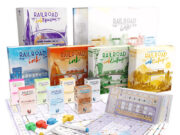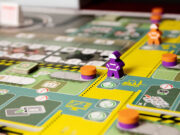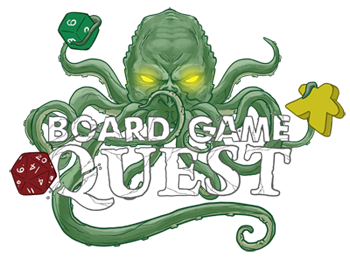 Sunrise at the Studio is another game in Pencil First’s line of small box games from designers Steve Finn and Eduardo Baraf, with art by Laura Bevon. Herbaceous is the only other one from this line that I’ve played, and I’ve always enjoyed it for its theme, accessible but engaging gameplay, and beautiful artwork.
Sunrise at the Studio is another game in Pencil First’s line of small box games from designers Steve Finn and Eduardo Baraf, with art by Laura Bevon. Herbaceous is the only other one from this line that I’ve played, and I’ve always enjoyed it for its theme, accessible but engaging gameplay, and beautiful artwork.
Following the line’s peaceful theme trend, Sunrise at the Studio sees 1-4 players competing for the most points as we throw clay and fire up the kiln, creating both artistic and useful works of pottery. Playtime is 20 minutes.
Gameplay Overview:
The goal is to have the most points after nine rounds. Players will earn points by completing project cards. Each player receives a starting project during setup, and four project cards are dealt face-up in the community play area. Each project card depicts the resources needed to complete it. Additionally, points can be gained via studio challenge cards, which reward players for completing a certain number of specific types of projects.
Resources for completing projects come from the resource deck and each card in this deck will depict one of the game’s three resources: clay, glazes, and kilns. There are three different varieties of each resource (i.e. clay comes in brown, gray, or white).
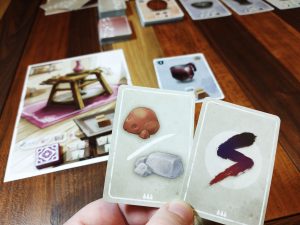
The game is played over the course of three days, and each day consists of three rounds. At the start of each round, players draw four cards from the resource deck, then simultaneously distribute their cards in one of three ways: keep three and pass one to the player on their left, keep two and pass one to the player on each side of them, or keep one and discard two, passing one to the player on their right. A different drafting option must be chosen each round of a day, so whichever one you chose during the first round, cannot be chosen in the next, etc… The cards a player keeps for themselves, as well as those passed to them by other players, are placed face-down on their studio mat.
Once every player has distributed all four of their cards for a round, they pick up all cards on their studio mat and use those resources to complete their current active projects. When placing a resource on a project, players discard the necessary resource card from their hand and place a resource token so it covers the matching icon on the project card. A project is completed once all of its resource spaces are filled. After completing a project a player takes a new project card and/or an advantage card which grants additional ways to score points. If players have resources they don’t need, they place one resource cube on the tray space of their studio mat. Two resource cubes from the tray can be spent any time to count as one wild.
At the end of the third day (i.e. the ninth round), players calculate their points gained from completed projects, challenge cards, advantage cards, and the cup of coffee card which is awarded to whoever collected the most coffee beans throughout the game. The player with the most points wins.
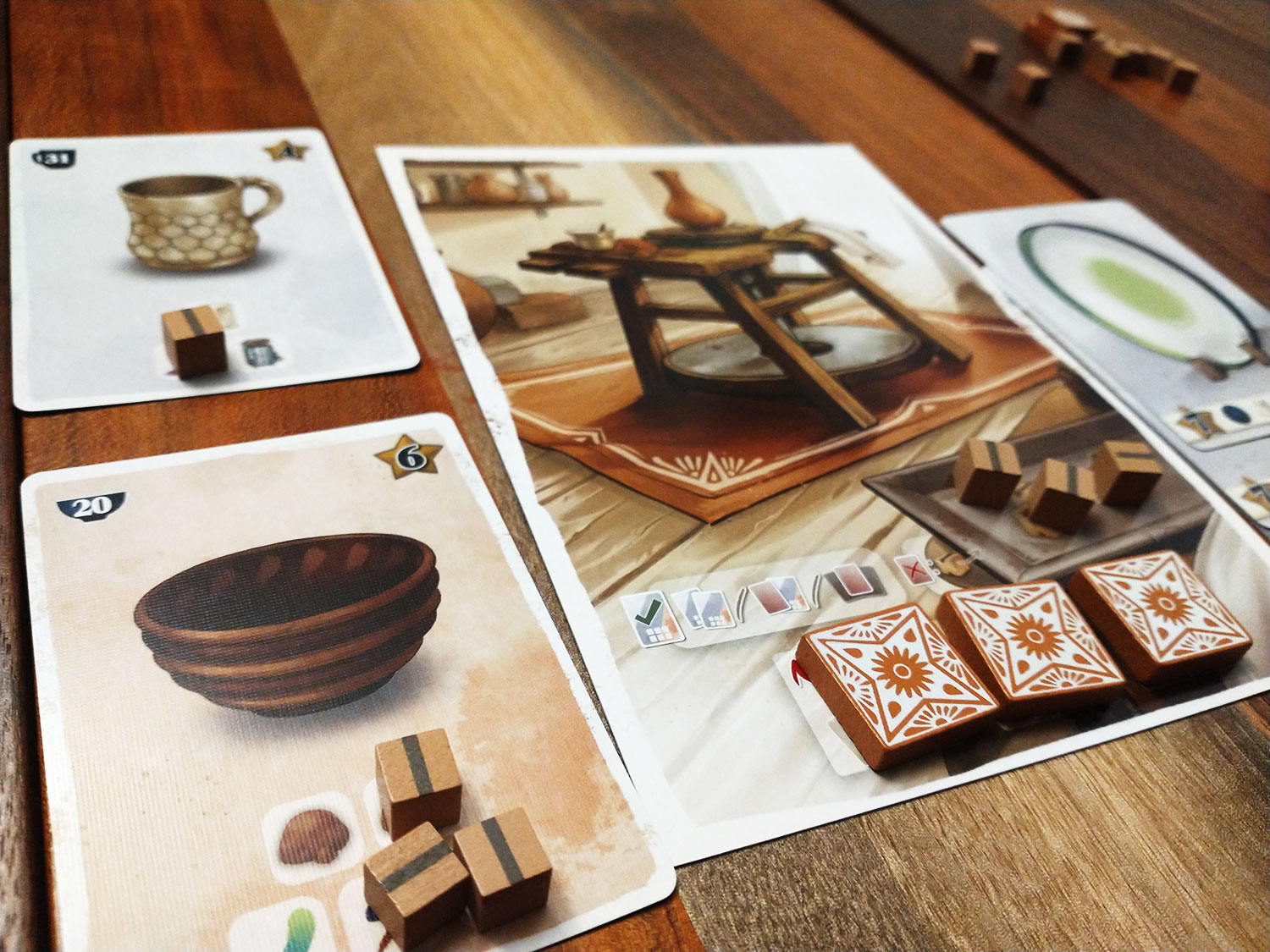
Game Experience:
As I was reading the rulebook I felt slightly confused about the gameflow and thought the rules seemed to be presented in an over-complicated way, but as I began to play it all came together and made sense, and it’s not difficult to remember the rules after one or two plays.
The diminishing choices about how you draft your cards each turn makes for just enough tension to keep you invested. If, on that first round of a day I draw a hand of resources I really need, I can opt to keep three and pass one along, but on the next round, I can only keep one or two. But if, in the final round of the day, I’m left with only the “keep one” option and I draw a lot of resources I like, too bad. I liked the slight turn of angst this provides. Even if the rounds where you end up with just one resource to place can feel frustrating, it balances out in other rounds where you end up with a healthy pile of resource cards. I never felt too frustrated or limited because of this.
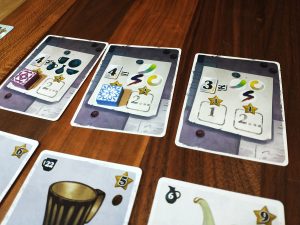
I appreciate that other players can influence your turn. You’re not in full control of the resources you end up with as some are passed to you by other players, but you can choose what to keep and what to pass along from the cards you were dealt. Maybe you have no use for a card but see that it would benefit the player you’d pass it to if you gave it up. Do you pass anyway, or do you hold onto it to deprive them?
Most often I chose to play the game at least semi-friendly, taking the resources I needed and passing along what I didn’t, regardless of what other players needed. But you could choose to play a more cutthroat game if you desired, though I use the word cutthroat lightly, since this is mostly a kind game. Those choices, however, give it just the right amount of interaction without feeling too mean. Players are also racing to complete challenges, with the player(s) completing them first gaining the most points, which is another means of competition. While I like that aspect of the game, I would have liked to see some more variety with the public challenges. Overall, I enjoyed the balance between player interaction and a more zen game experience.
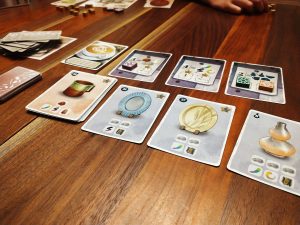
The game works well across all player counts and game length feels good, with our plays typically taking around thirty minutes. I think the replay value will be decent due to interesting and engaging mechanisms and competition. My kids asked to play this one frequently, but it’s also one I’d take out to play with serious gamers as a filler, or as a lighter game option for casual players. I also found the solo variant engaging and well designed, but it feels less relaxing than the multiplayer game because it adds a little more to the mental load.
Final Thoughts:
I think Sunrise at the Studio is going to fit into a similar spot in my collection as Herbaceous (though actual gameplay is very different). There’s good decision space for being a lighter game and it will work equally well with experienced gamers and newer players. The theme and artwork are pleasant which lend to the relaxing feel of the game. This is one I can see staying in my collection for a long time.
Final Score: 3.5 stars – An idyllic and relaxing choice for a “sunrise at the game table” play
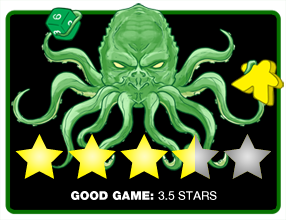 Hits:
Hits:
• The card drafting is fun and unique
• The game flows well and turns are quick
• Nice tension from diminishing choices
Misses:
• Would have liked a little more variety with the public goals
• Rounds when you have few resources can be uneventful



